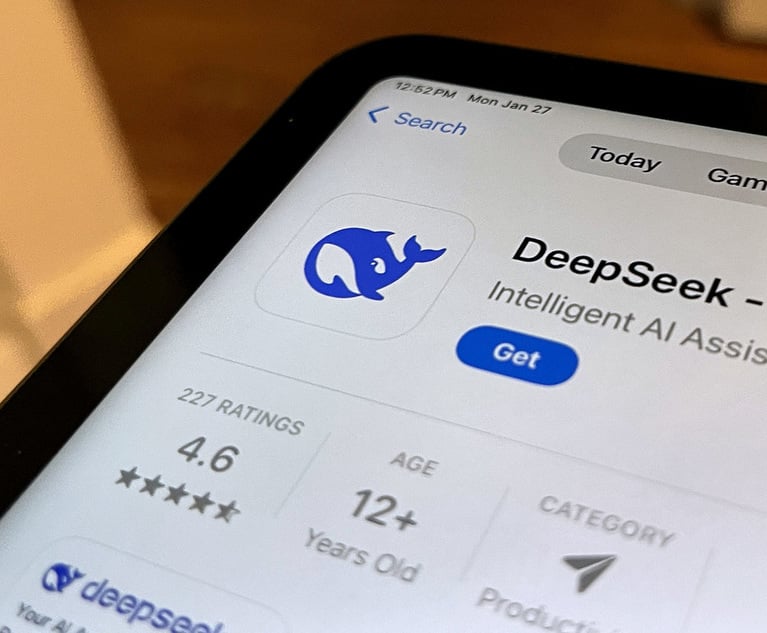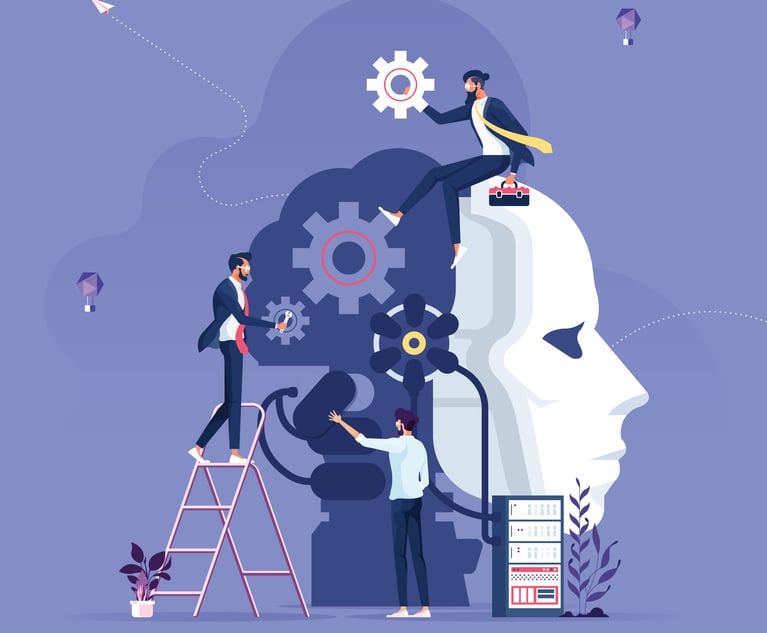The Future of Legal Tech Is About Transformation, Not Automation
Legal technology has so far shifted the industry incrementally. The next decade could change that.
January 15, 2020 at 03:30 PM
9 minute read
The original version of this story was published on Legal Tech News
 Credit: Shutterstock.com
Credit: Shutterstock.com
The year is 2030. The fight at the top of the Am Law rankings is between divisions of Deloitte and EY. Many lawyers work from home because local and state courts have largely moved online. Artificial intelligence has made contract drafting and review nearly nonexistent. Most new lawyers are fine with that, anyway, because they came out of law school with AI certifications.
You've heard this before, right? Perhaps, this is the future that legal technologists (or even George Orwell) would have you see. But the reality could be much different.
"The pace of change is glacial," says James Sandman, president of the Legal Services Corp. "The practice of law to me looks very 20th century, maybe even 19th. For all the talk about change in the practice, I'm not seeing change at a rapid pace. No better than linear."
Maybe this is all missing the point. Author and futurist Richard Susskind says he's seen change in legal, but it's just not the right kind of change. "People say, 'Of course we'll be using technology.' They'll say things like, 'It's just another tool for us,'" he explains. "That's just thinking in terms of automation; it's missing the transformation point."
Transformation is a tricky term. It implies change in such a wholesale fashion that the industry can never return to what it once was. One could argue that transformation in law hasn't really occurred since the Magna Carta, and later the U.S. Constitution, which gave rights for due legal process. Despite quality of life and efficiency improvements, the concept of lawyering has largely remained the same: take a case, gather the facts, argue a case, a judge or jury rules.
So what makes the coming decade any different? Technology, and a desire for change.
It Starts in Utah
At its core, law is different from other industries. There isn't much room for an equivalent to Uber, Zillow or Expedia because regulations simply don't allow it. The American Bar Association's Model Rules of Professional Conduct (Rule 5.5) and all state bars have regulations against the unauthorized practice of law, meant to keep nonlawyers from doing clients a disservice in the legal system.
"The difference is the regulatory system, which is a real deterrent to innovation," Sandman says. "It scares people off, being hit with an unauthorized practice claim, the prospect of litigation at the outset of any potential innovation stopping you in your tracks."
The regulatory system, though, is not impenetrable. Arizona, California, Illinois and Utah have begun attempts to amend their legal rules of professional conduct and expand law firm ownership to non-Juris Doctor holders. Of the four, Utah is largely seen as the leader. In August, the state's supreme court voted unanimously to approve a pilot program loosening regulatory restrictions on the corporate practice of law and a regulatory body to oversee nontraditional legal services.
Bill Henderson, a professor at the Indiana University Maurer School of Law focusing on legal technology, says the shift was bound to happen, especially as data has increasingly become a major part of litigation. He points to the U.K., where it took 15 years after liberalization, but now "everybody, from the most junior person to the most senior person, are all incentivized to innovate on behalf of the customer." Ultimately, he says, "I believe that these rules need to be liberalized because it will create a higher-quality collaboration between lawyers and subject-matter experts."
But even beyond Utah, in states where such regulatory loosening has not yet occurred, it may only be a matter of time. Sandman says Utah could be a testing ground not only for legal technology's impact on law, but its public acceptance as well.
"If you see innovation there that really benefits consumers at every level by making process more open and accessible, I think you will see build across the country a desire for similar innovation in other jurisdictions," he says. "People will look to a Utah and say, 'Hey, why do they get that but we don't?'"
Power to the People
The lifting of some regulatory restrictions has long been linked to tech-centric entrants to the legal market, as well as process-focused consultancies and accounting firms—namely, the Big Four.
Jason Barnwell, a corporate legal operations professional and member of the board of directors at Corporate Legal Operations Consortium, says the injection of different competitors could radically change the market.
"All it takes is a service that is good enough and that addresses a pain point with adequate commonality, typicality and numerosity," he says.
He notes that big-ticket work has driven investment, because there has been demonstrable return on investment by automating simple legal tasks.
"Changing the massive amounts of small legal work that are the glue that holds business together has transformational capability," Barnwell says.
From his vantage point, Don Fancher, U.S. and global forensic leader at Deloitte, sees much of that work already changing. When it comes to the billable hour and work that has historically been viewed as "associate work," such as contract review, "the reality is that's going away already, even without the advent of technology, through the use of alternative legal service providers," he says. Not only does Deloitte have its own contract management solution with dTrax, but companies such as Kira Systems and Seal Software are increasingly introducing natural language processing to legal processes, he notes.
The changing regulatory system is "certainly something that we're watching, the other Big Four are watching, alternative legal service providers are watching, and looking to see how those come forward," Fancher says. But he doesn't think "it's a slam dunk that the doors are just going to open and anybody can now provide legal services," pointing to California's changing guidelines as an example of regulatory loosening that maintains restrictions.
Besides, one of the entities most suited to tackle the changing paradigm may very well be the firms that already interact with clients on a daily basis—as long as they recognize the need for new, tech-centric personnel. Wendy Butler Curtis, chief innovation officer at Orrick, Herrington & Sutcliffe, predicts a future where law firms will be comprised of data scientists, project managers, business analysts and developers as trusted and valued members of the matter team. And in-house legal teams, she says, "will be at most 50% lawyers, with at least 50% legal professionals."
"It's going to eliminate that dichotomy of the lawyer/nonlawyer," she says. "You see that now, like in the discovery space. … The person who understands how to use predictive coding—that person has equal value and equal import to the lawyer who has the subject-matter expertise of the issue in the case."
Though law firms have historically had a reputation of being slow-moving to make this kind of change, Curtis believes they can rapidly adapt in this case for a simple reason: They're following their clients' lead. Just look at the rise of corporate legal operations departments and how many already report directly to the general counsel. "It's already happening, and the leading law firms are catching up," she says.
A Face-to-Face Connection
Curtis believes that not only will the people on legal teams change, but so will their processes and technology. Spending more time outside the office will become commonplace as law firms and legal departments adopt collaborative technologies and reduce real estate costs. But rather than simply furthering remote work, she says, easier-to-use video technologies similar to FaceTime can actually promote efficiency and job satisfaction by putting the human element back in business communications.
"When I turn on my computer, whoever is on the other side of that communication will immediately be able to see me, weave the nonverbal communications, and we will be talking," she says. "The geographic distance becomes immaterial. If I can see you, it becomes so much more important than being next to you."
This emphasis on face-to-face communication could have implications beyond internal work, Susskind says. His new book, "Online Courts and the Future of Justice," posits that video technologies are crucial to revolutionizing courts themselves, potentially opening up a court system where only 46% of people have access to deal advisers and court systems worldwide, per the World Justice Project.
His idea centers on online courts that people can use themselves. Lawyers wouldn't be a necessity, "as the current model doesn't scale up," he says. The first generation in the immediate decade would see human judges at the controls, deciding cases online. The second generation of online courts would also help people understand their rights, and offer alternative dispute resolution through artificial intelligence.
"If we're going to invest in the access to justice problem, it cannot be by throwing more lawyers and judges at all of these problems. It seems to me what we need to do is find a way of making the law and legal service accessible," Susskind says.
Sandman agrees that radical change is necessary for true access to justice, and if the type of change Susskind suggests is going to occur in the next decade, the judiciary will be the impetus. He explains, "Judges see that the system isn't working. There are family court judges across the country that will tell you it's an unusual day when any lawyer appears in their courtroom."
It's a tall ask, overhauling the legal system on the fly. It may mean that transformative change isn't imminent in the next decade. But the seeds are there. Changing mindsets is the next step.
Susskind likes to tell the story of a power tool executive who asks a room of his salespeople what the company sells. Of course, they answer, we sell power drills. The executive shakes his head, then flips to the next slide. It's a freshly made hole in the wall. That, Susskind relates, is what customers want: what the drill provides, not the drill itself.
"We need to stop thinking that we need to make a better power drill," he says, "and start thinking more fundamentally. What's the value we bring as lawyers or as courts? Can we deliver that value in new ways?"
Email: [email protected]
This content has been archived. It is available through our partners, LexisNexis® and Bloomberg Law.
To view this content, please continue to their sites.
Not a Lexis Subscriber?
Subscribe Now
Not a Bloomberg Law Subscriber?
Subscribe Now
NOT FOR REPRINT
© 2025 ALM Global, LLC, All Rights Reserved. Request academic re-use from www.copyright.com. All other uses, submit a request to [email protected]. For more information visit Asset & Logo Licensing.
You Might Like
View All
U.S.- China Trade War: Lawyers and Clients Left 'Relying on the Governments to Sort This Out'

DeepSeek Isn’t Yet Impacting Legal Tech Development. But That Could Soon Change.
6 minute read
From Laggards to Tech Founders: Law Firm Innovation Is Flourishing

Government Contracting Clients Look to Firms to Stay on Top of Trump Policy Changes
4 minute readLaw Firms Mentioned
Trending Stories
- 1Parties’ Reservation of Rights Defeats Attempt to Enforce Settlement in Principle
- 2ACC CLO Survey Waves Warning Flags for Boards
- 3States Accuse Trump of Thwarting Court's Funding Restoration Order
- 4Microsoft Becomes Latest Tech Company to Face Claims of Stealing Marketing Commissions From Influencers
- 5Coral Gables Attorney Busted for Stalking Lawyer
Who Got The Work
J. Brugh Lower of Gibbons has entered an appearance for industrial equipment supplier Devco Corporation in a pending trademark infringement lawsuit. The suit, accusing the defendant of selling knock-off Graco products, was filed Dec. 18 in New Jersey District Court by Rivkin Radler on behalf of Graco Inc. and Graco Minnesota. The case, assigned to U.S. District Judge Zahid N. Quraishi, is 3:24-cv-11294, Graco Inc. et al v. Devco Corporation.
Who Got The Work
Rebecca Maller-Stein and Kent A. Yalowitz of Arnold & Porter Kaye Scholer have entered their appearances for Hanaco Venture Capital and its executives, Lior Prosor and David Frankel, in a pending securities lawsuit. The action, filed on Dec. 24 in New York Southern District Court by Zell, Aron & Co. on behalf of Goldeneye Advisors, accuses the defendants of negligently and fraudulently managing the plaintiff's $1 million investment. The case, assigned to U.S. District Judge Vernon S. Broderick, is 1:24-cv-09918, Goldeneye Advisors, LLC v. Hanaco Venture Capital, Ltd. et al.
Who Got The Work
Attorneys from A&O Shearman has stepped in as defense counsel for Toronto-Dominion Bank and other defendants in a pending securities class action. The suit, filed Dec. 11 in New York Southern District Court by Bleichmar Fonti & Auld, accuses the defendants of concealing the bank's 'pervasive' deficiencies in regards to its compliance with the Bank Secrecy Act and the quality of its anti-money laundering controls. The case, assigned to U.S. District Judge Arun Subramanian, is 1:24-cv-09445, Gonzalez v. The Toronto-Dominion Bank et al.
Who Got The Work
Crown Castle International, a Pennsylvania company providing shared communications infrastructure, has turned to Luke D. Wolf of Gordon Rees Scully Mansukhani to fend off a pending breach-of-contract lawsuit. The court action, filed Nov. 25 in Michigan Eastern District Court by Hooper Hathaway PC on behalf of The Town Residences LLC, accuses Crown Castle of failing to transfer approximately $30,000 in utility payments from T-Mobile in breach of a roof-top lease and assignment agreement. The case, assigned to U.S. District Judge Susan K. Declercq, is 2:24-cv-13131, The Town Residences LLC v. T-Mobile US, Inc. et al.
Who Got The Work
Wilfred P. Coronato and Daniel M. Schwartz of McCarter & English have stepped in as defense counsel to Electrolux Home Products Inc. in a pending product liability lawsuit. The court action, filed Nov. 26 in New York Eastern District Court by Poulos Lopiccolo PC and Nagel Rice LLP on behalf of David Stern, alleges that the defendant's refrigerators’ drawers and shelving repeatedly break and fall apart within months after purchase. The case, assigned to U.S. District Judge Joan M. Azrack, is 2:24-cv-08204, Stern v. Electrolux Home Products, Inc.
Featured Firms
Law Offices of Gary Martin Hays & Associates, P.C.
(470) 294-1674
Law Offices of Mark E. Salomone
(857) 444-6468
Smith & Hassler
(713) 739-1250










